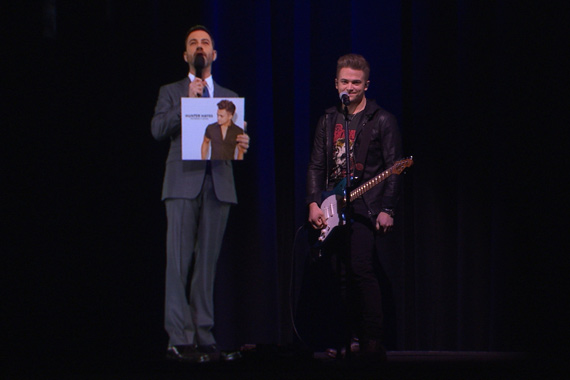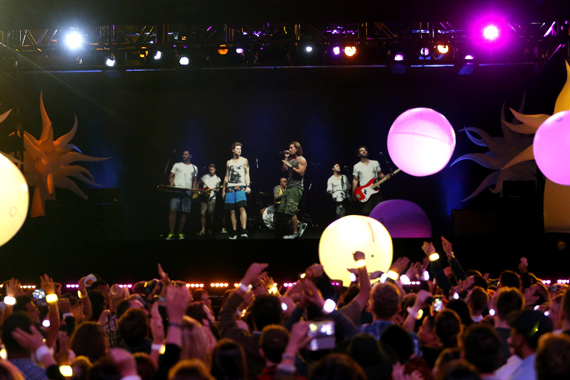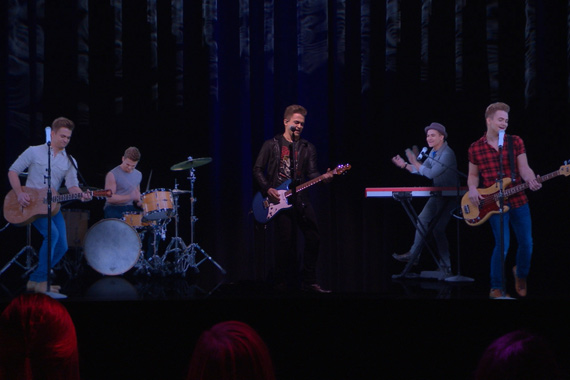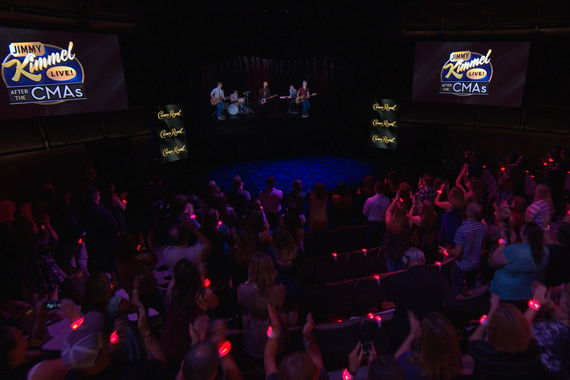

Jimmy Kimmel (L) appears at Nashville’s CMA Theater via hologram from Hollywood, California next to Hunter Hayes (R). Photo: ABC
A few months after HologramUSA’s 2014 launch, Sr. VP of Sales, David Nussbaum, worked out a deal with Jimmy Kimmel Live! Co-Executive Producer, Doug DeLuca, to pair its technology during CMA Awards week on the ABC broadcast. This year Hunter Hayes took center stage before his holographic one-man band—playing every instrument and singing—on his latest single, “Yesterday’s Song.”
Nussbaum gave MusicRow a behind-the-scenes look at the technology and its future in live events. HologramUSA was founded by Greek billionaire Alki David and a European partner who had control over the decades old patented technology. It is part of FOTV Media Networks, which plans to go public on the Nasdaq later this fall.
HologramUSA has gone on to announce, but yet to deliver on, deals with estates of many entertainers like Patsy Cline and Tammy Wynette.
– – –
How have the Kimmel events progressed over the past three years?
Jimmy Kimmel’s producers originally thought it would be cool to beam Jimmy in real time from his studio in Hollywood, while he was doing his monologue in front of his studio audience, to the CMA Theater in Nashville. The folks in Nashville saw him as if he was really there and we had a reverse feed going back to him, so Jimmy could hear, see and interact with the audience whether it be in there or anywhere around the world.

Florida Georgia Line hologram on Jimmy Kimmel Live! in 2014. Photo: ABC/Randy Holmes
Then we beamed Florida Georgia Line from the CMA Theater back to Hollywood. Never had that been done before, where we had sent one person one way, and an entire musical group in another direction. Last year we sent The Band Perry back in real time, performing from Nashville on Kimmel’s outside, 40-foot stage in Hollywood, and we did a fun multiplicity thing with Guillermo. This year we took that idea and made it less silly.
It was always an idea of mine to have a really talented, single performer perform live with their holograms. All the stars aligned, Hunter was in to the idea, so we filmed him playing four different ways during the same song with our special hologram technique. Then my editors put all the images together, added depth and shadows, to create an entire band of Hunter Hayes’. I appreciate everyone at Kimmel for giving us the opportunity.

Hunter Hayes Hologram. Photo: ABC
How did the audio work for the Hunter[s] performance?
I don’t know exactly how the producers did it. I’m not a producer, but I believe they replaced the track with a layered individual performance but each instrument was played separately as we filmed.
Outside of TV, how else has hologram technology been applied?
A lot of people know of this technology because of what we’re able to do bringing the dead back to life to perform posthumously. But not many people know about the ability to beam anyone from anywhere and even multiply them.
We also sent the actor Jack Black form Los Angeles to Madrid, live via hologram so he could be at a press junket for that he couldn’t be at because he was filming a movie. A journalist would sit down with his live hologram every ten minutes over the course of two hours. So he was able to promote it in real time to Europe without ever leaving Los Angeles. He did print and video—some TV shows like the Extra’s and Access Hollywood’s of Spain all ran it.
Live concerts is the future of this technology. It makes a lot of sense as a new way for people to experience live entertainment. For example, I can bring anybody back with the approval of the estate of the late icons. Name an artist, if the estate sees value in it, we would create a hologram that can live in residency, as a museum piece or go on a real hologram concert tour.
Do you rotoscope old footage for deceased stars, or draft new CGI images?
We feel the best way to create a hologram is to work with the estate for video and picture references to use CGI and other digital methods to recreate the person from head to toe. The estate has a number of approvals along the way to make it all as authentic as possible. We don’t use any voiceovers or impersonators. There are also ways to get creative and match their voices, which is what happened when Tupac’s hologram played Coachella a number of years ago when he said “What the f— is up Coachella.” Coachella was not a thing before he passed, so obviously the producers behind that got creative.
What is the status on the hologram projects you’ve already announced?
Four days before Kimmel [this year, Oct. 29], we brought the late star Jenni Rivera back to life for 70,000 people at the Day of the Dead festival in California. I worked with her family and Universal Music, who owns the rights to the music. They have already announced doing this again in March and the idea is to tour her hologram.
HologramUSA is partners with 19 estates spanning music and entertainment. Many are in pre-production now. I don’t think you’ll have to wait much longer for the first one to come out—probably as early as spring-summer 2017. We’re researching how long people will want to watch a hologram and if they want to see a real band behind a hologram, etc. We want the first hologram concert to be right, so when the first one takes place it will be more than anyone imagined.
Are living artists approaching you to record and store their polygons for use at a later date?
Yes. Some of the biggest stars in the world have walked through our studio in Beverly Hills. We’ve partnered with many of them on legacy holograms, where we film them, while they are alive, singing their hits. When the time comes—not even if they’ve passed, but if someone in their band is sick or they wanted to retire.
What is the cost of stunts like these? The Kimmel event this year was clearly sponsored by Crown Royal.
Just to build a hologram projection stage for a day, it would cost $100,000+ just for the tech. Permanent installations at a venue may be between $500,000 to $1 million. To bring somebody back as a hologram can cost from hundreds of thousands to low seven figures. It really just depends on the hologram and how long it will run, every minute of animation has a value to it.

Hunter Hayes hologram at Nashville’s CMA Theater. Photo: ABC

About the Author
Eric T. Parker oversees operations and contributes editorial for MusicRow's print magazine, MusicRow.com, the RowFax tip sheet and the MusicRow CountryBreakout chart. He also facilitates annual events for the enterprise, including MusicRow Awards, CountryBreakout Awards and the Rising Women on the Row. eparker@musicrow.com | @EricTParkerView Author Profile


